Your typical airline headquarters and operations center is somewhere near a major hub airport, usually in some nondescript building with views that don’t really inspire much of anything. United, however, couldn’t be any further from the norm. Inside Chicago’s Willis Tower, once the tallest building in the world, the once largest airline in the world is managed by motivated individuals around the clock.
I have been to a few airline operation centers in the past, but never the control center of an airline quite as massive as United. Hundreds of people, across an entire floor of the Willis Tower, are dedicated to keeping United and United Express moving efficiently and safely, a task that is far from easy.
The Network Operations Center, or NOC, is split right down the middle of the floor. One half is in charge of narrow-body operations, the other side handles wide-body flights. There is a strict division of labor in this respect, and employees sort of ’œgraduate’ from one side of the room to the other.
The airline has grown so large, in fact, that they have run out of room on this floor of the Willis Tower. Plans are being discussed to break through the ceiling and move some NOC employees up to create more space (one might say that United needs to Keep Climbing).
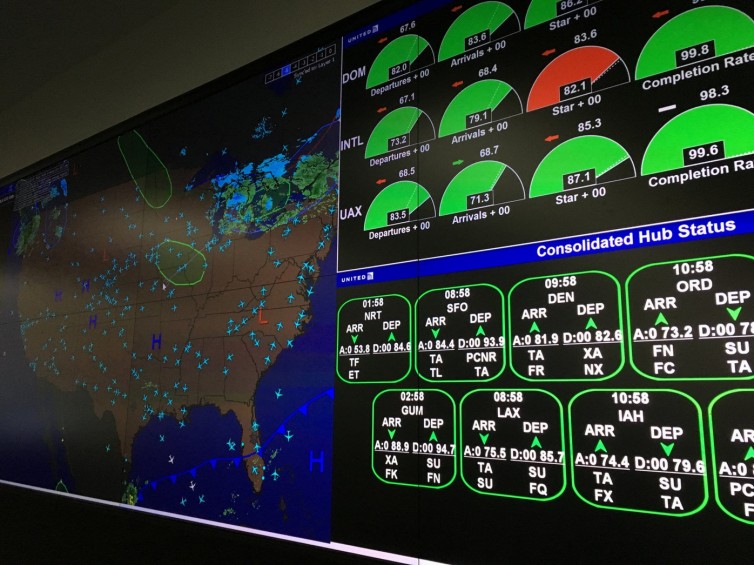
The entire airline’s operational health is summed up in just a few snapshots – Photo: Jason Rabinowitz
Located at the center of the two sides is what is know as ’œthe bridge.” Here, top-level decision makers oversee the entire operation. Opposite from them is a large set of monitors with various operational health measurements, from the status of United hubs to a list of flights that may be pushing the tarmac delay rule. In one glance, any employee can get a snapshot of the entire airline’s operation in real-time, plus predictions for the rest of the day.
Across the floor, different teams of employees have dedicated tasks. To the right of the monitors sits the air traffic control, or ATC, team. To the left of the monitors is the weather team. The information flowing from these teams moves over to other nerve centers, like aircraft dispatch and crew management. This is to make sure that both aircraft and crews get to where they are needed before any adverse weather or air traffic control constraints occur.
One station caught my eye in particular. During irregular operations and flight disruptions, the task of getting every passenger re-booked and on their way is complex and critically important. A relatively new tool used by United can automatically re-book all passengers from a wide-body aircraft in just a few minutes.
But it doesn’t just re-book passengers randomly or by seat number. It actually takes into account each passenger’s airline status and gives those passengers priority over others. A passenger with 1K Premier status is going to be given preferential re-booking over those with lesser status, or no status at all.
Towards the back of the floor, things get a little more quiet and mysterious. There’s a room which I am not allowed to discuss, an also a rather innocuous looking conference room. This room is activated during irregular operations and after incidents, and is a room no employee ever hopes to set foot in. Seats are occupied by representatives from various departments such as dispatch, crew scheduling, media relations, and so on. Drills are occasionally held throughout the year so that they are ready in the event of a real situation.
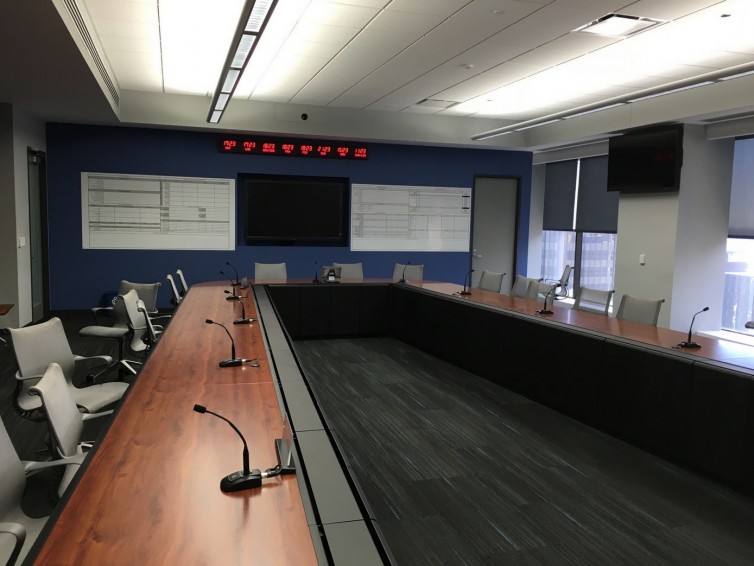
This conference room is used during irregular operations or after incidents. An empty room is what you want to see – Photo: Jason Rabinowitz
The United NOC is staffed 24 hours a day, 365 days per year, and the work never stops. It literally takes an army of people to keep the operation moving, or in this case, an entire floor of a massive skyscraper.
All of this happens behind the scenes, isolated from the front-line staff and airport employees. The next time your flight is a little bit delayed, pause for a moment and think about about how complicated it is to juggle so many flights and how the fine folks in downtown Chicago are trying to get you to your destination.
View more photos of my United Airlines NOC tour on Flickr.
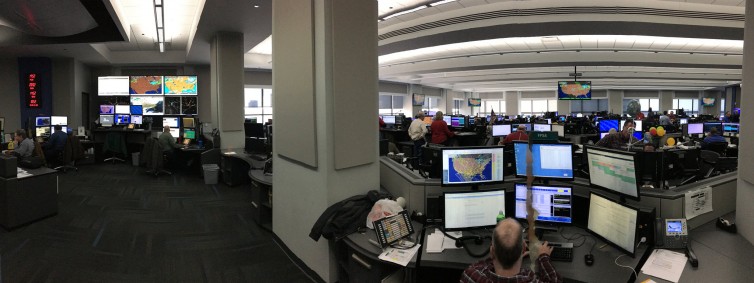
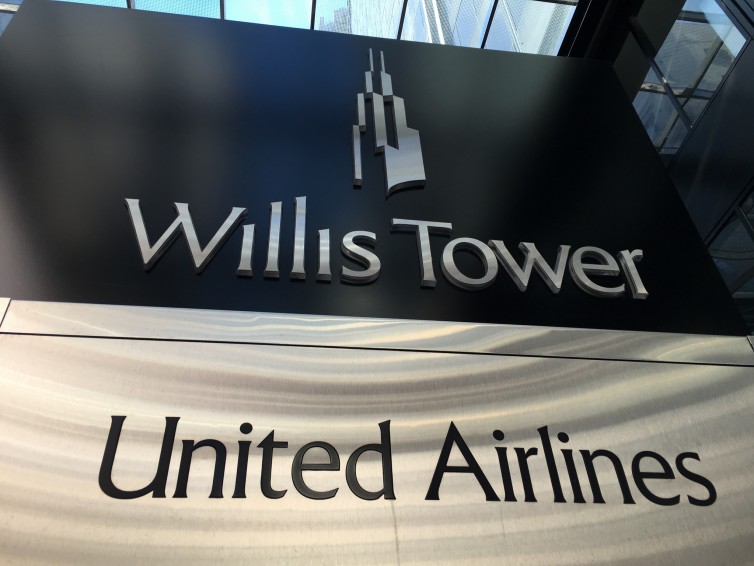
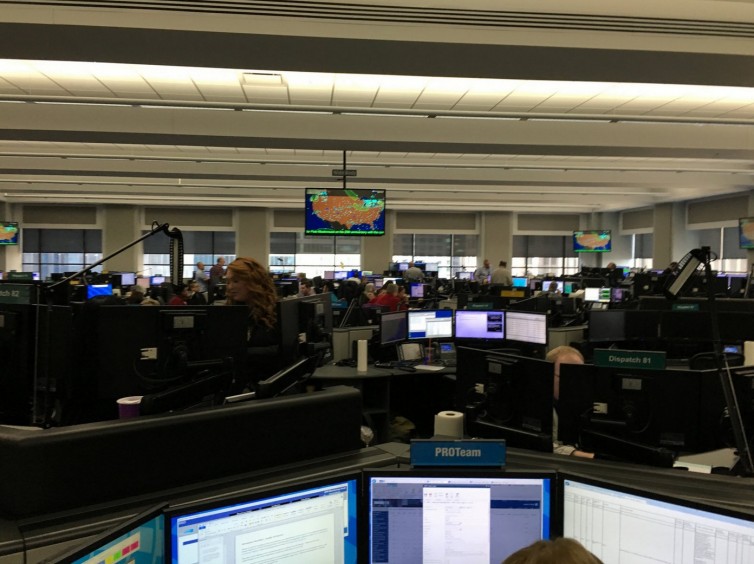
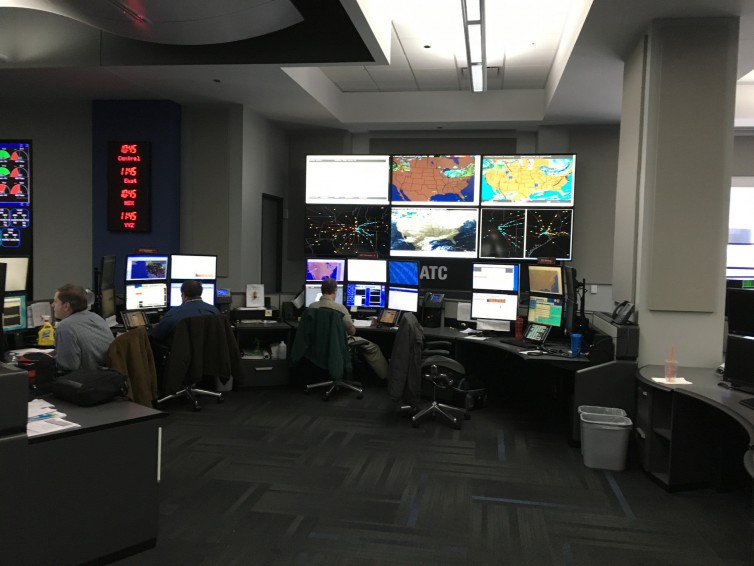

I don’t believe much of what United told you on tour. I have had numerous delayed flights from SEA to SFO and onwards. Although I fly First Class and have had MP G status for many years, I have never ever found that United has re-booked flight connections for passengers on late arriving flights at SFO. I have waited in lines up to 2 hours at SFO for re-booking and it is very frustrating that United doesn’t have a system to view planes arriving multi-hours late and automatically re-book pax on connecting flights. Plus the United staff at SFO are extremely rude and grouchy.
Over the summer, I missed a connection at ORD due to crew issues. I don’t think I was rebooked, but as soon as I landed and turned on my phone the United app gave me rebooking options.
Whenever I have flight delays, even those as short as 15 to 20 minutes and have a connecting flight, I get a message in the United app that allows me to choose from several logical options, seemingly any of the next several flights with an open seat. Further, it generally books me on a backup flight, being the next flight with an open seat, then I can go in and change the flight if I deem it necessary. I’m a 1K, nearly always on low fares, flying on W/V 4-6 times a year (for reasons obvious).
What’s in the secret room?
They don’t call it the secret room for nothing!
David | AirlineReporter
The mystery surrounding the room is because it is used as a command center in the event of an aircraft incident. Hence, why they say that it hopefully never gets used.
I work in transportation myself–not airlines–for one of the “big four” companies–in fact, I work in a Network Operations Center quite similar in concept to United’s. We also have the “wall of screens” showing data, with various workgroups scattered across a huge floor perhaps 300′ X 200′. The building has no windows and supposedly can survive a large tornado (though we’ve never tested that one out). It all looks impressive to visitors, who are universally wowed by the place. “It looks like Mission Control!” they all say. Some days it functions better than others. We’re in the suburbs; I can’t imagine having such an operation in the middle of a huge city in a skyscraper– I hope they have an alternate location they can relocate to in a hurry in the event of a natural or terror attack.
I don’t know about the “Secret room” (maybe that’s where the vending machine are?) but we also have what’s called a “War Room” to plan recovery from disasters, interruptions, etc. I visited a similar facility in Australia and the guy giving the tour was amused with us calling it a “War Room.” “You Yanks are all about wars and violence, aren’t you?”
I’d like to see a similar look at American’s operations near DFW.
I was on the design/implementation team for this project and was responsible for the video walls/screens/collaborative software in the GNOC, EOC, War Room and other A/V systems in 125 meeting spaces/training rooms at Willis. I spent two years with my team onsite there and gained a very in-depth understanding of United’s business. The answer to your question is yes they do have a back-up facility.
While I have participated in the design and technology specification/deployment for hundreds of mission critical projects over my 25 years working with customers like UAL, I have to say that this project opened my eyes to the reality of what effort it takes to get a plane off the ground in one city and land it (safely) in another; it is a monumental task that involves literally hundreds of people in disparate locations all working under incredibly difficult logistics (time lines, weather challenges, mechanical issues, staffing problems, etc.). It is absolutely an understatement for me to say that I personally witnessed United’s staff doing everything possible to facilitate the transaction of launching and landing a plane safely and on-time. I am not suggesting they don’t have their challenges….as do most airlines I have flown on, but my experience on this project has helped me to be a little more forgiving than I had been in the past.
The comment about the WOW factor is very true….and many of my customers will not do anything different despite my attempts to argue the point that they should put some of the WOW factor money into the software side of the operation to automate processes, create more efficiencies, improve situational awareness, and collaborate with others more easily; but at the end of the day they write the check, and unless it is just absolutely not the right thing to do, they get to decide how to spend their money.
I am sure their is a backstory about why Willis was the selected site 🙂
I have worked for the three majors and yes they do have automated rebooking systems in place to reschedule passengers but when the entire region has a weather issue, it changes from second to second and sometimes jams, they have mandatory overtime at AA res when that happens, ALL hands on deck. Some airlines out source their reservations late at night. When I worked AA res, we git calls from the Phillipines UA’s outsource res and those folks don’t play nice! MAINLINE UA res was awesome, as was Delta, US Air…. LISTEN UP FLYING PUBLIC.. it is ONE CHURCH, different pews… we are all dealing as best we can to meet your needs, so chill out. The computer res system is not HUMAN and sometimes there are glitches, freeze frame etc. So relax. Only Mother Nature and God will prevail, relax SAFETY IS PARAMOUNT… there is no perfection on EARTH… only angels trying to fly you home safely!
Very cool place to work at. This floor has redundancy from VOIP/analog and turret OS based phones to dual mirrored Telecommunication rooms and UPS/Generator power. Automated lighting and blinds, its own A/C system separate from the building along with water supply. It will basically sustain itself.
@Jason– No, the command room isn’t the secret room. Reading over that paragraph carefully, the author is saying that there’s two rooms–one she cannot discuss, and one used for emergency conferences. “There”s a room which I am not allowed to discuss, an also a rather innocuous looking conference room.” Note the “an also a” phrase, which makes no sense unless she made a misspelling of “and”.
It would be weird if she just discussed the room she’s not allowed to discuss.